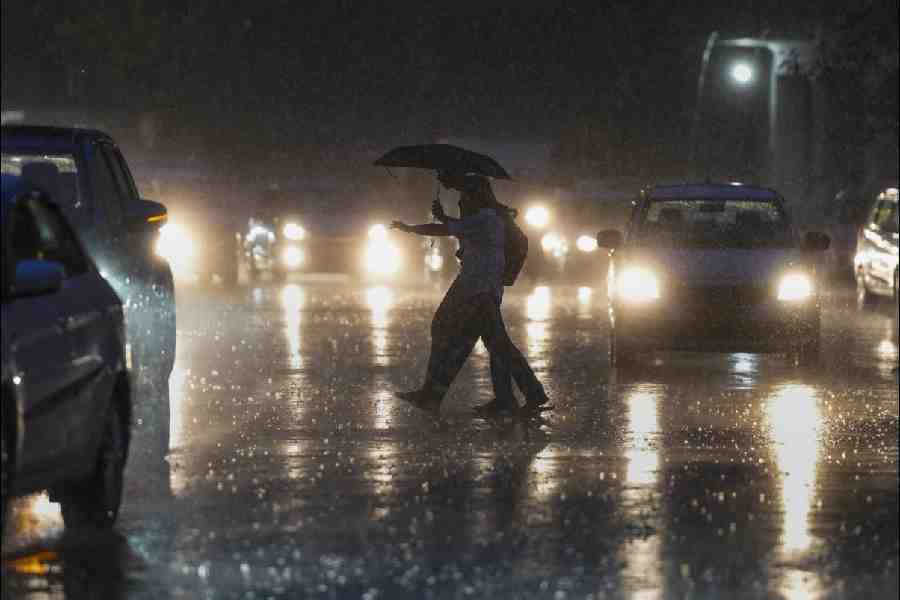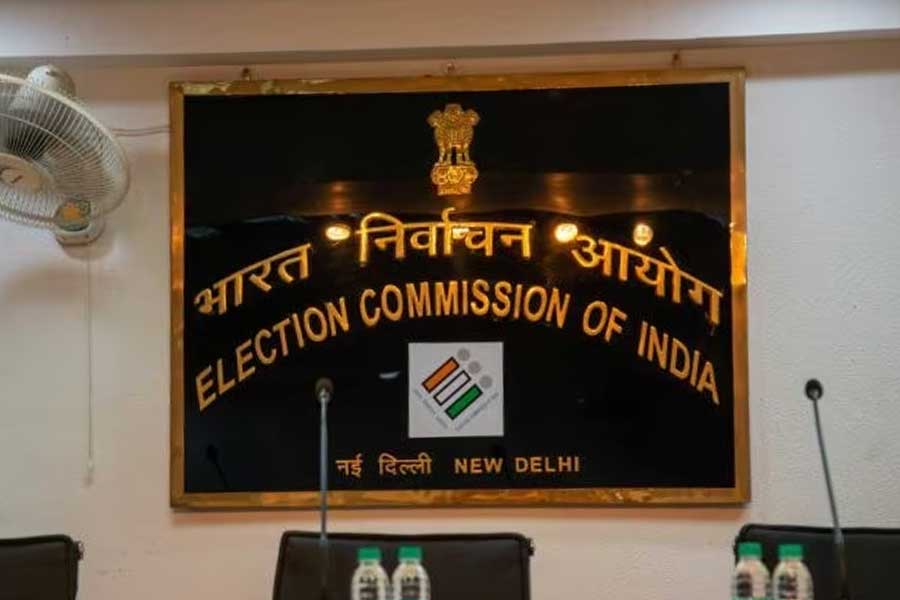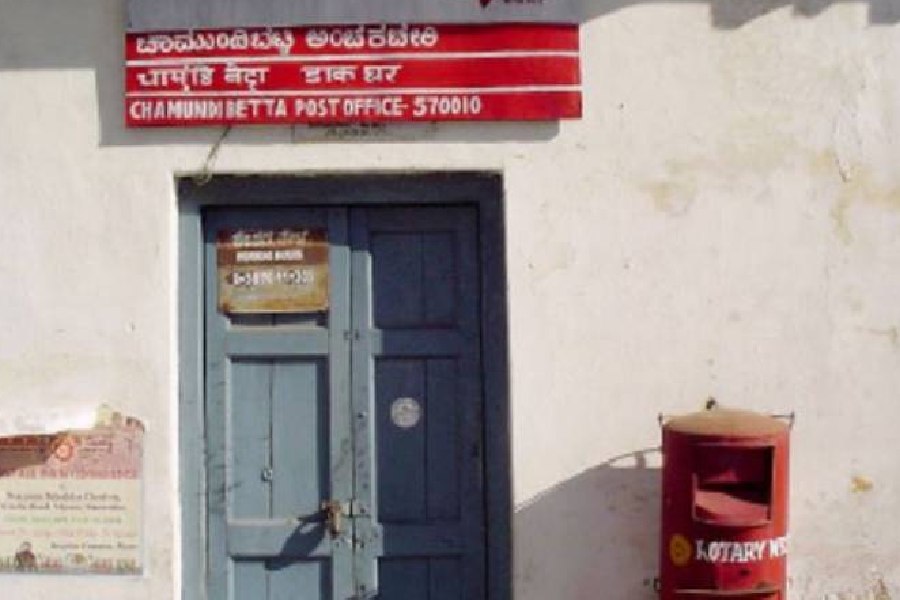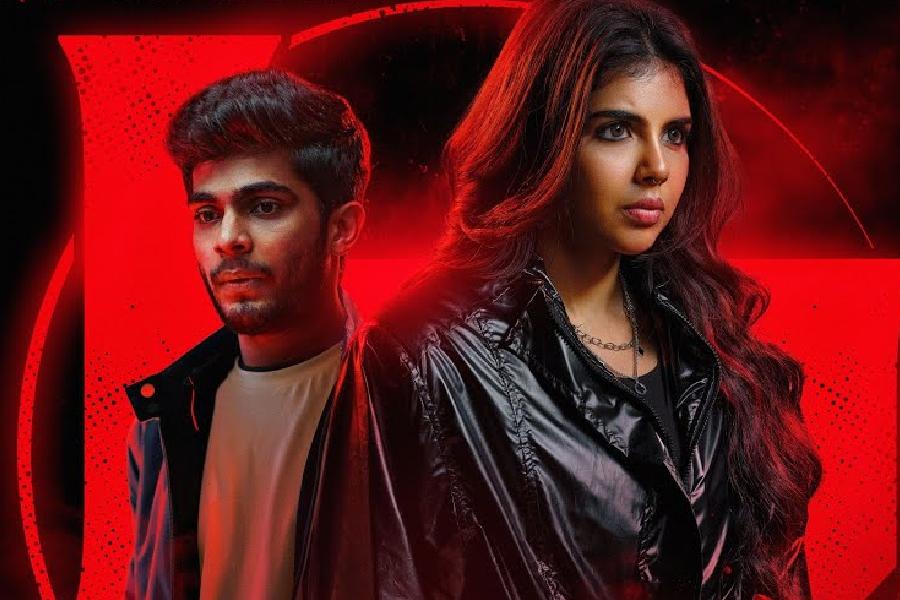 |
| Aparna at her home in Silver Spring. Picture: Rashbehari Das |
At 10 past 10 on Monday morning, we find her ready to go — for the t2 photo shoot and also a long day at work. In the living room of her Silver Spring apartment, Aparna Sen smiles into the camera and fidgets. Our photographer requests for a change of costume, which she politely turns down. “I don’t understand why people still treat me like an actress and not a director,” she rues, as we move into a cosier part of the room to talk about Goynar Baksho, a long-cherished dream of hers that hits the theatres on April 12.
Aparna: I am rushing through a very difficult film...
Why very difficult?
Well, it’s set between 1949 and 1971. And then there’s a flashback to an even older period. It’s difficult to get the kind of environment and places that were there at that time....
But isn’t Shirshendu Mukhopadhyay’s novel set in more contemporary times?
Actually, there’s no timeline given in the book. I had read it in 1992, I think in a Sharodiya sankhya, though the book was probably released in 1993. See, my rationale is that if it is not set further back in time, then the rebellion of a young woman — Somlata — stepping out of her house to set up a business does not hold water. Her daughter Chaitali (who is Basan in Shirshenduda’s book) is born in 1953. She’s 18 in 1971 when the Bangladesh Muktijuddho happens.
It’s a story about the journey of a box of jewellery that is passed down from one generation to the next. Through the woman’s relationship with jewellery in each successive generation, we explore the changing position of women, both economically and morally. Pishima was born in the 19th century. She’s a hoarder. She has the keen intelligence to know that because she has the goynar baksho (jewellery box) in her possession, she has an important position in her brothers’ feudal household. It’s a strongly feminist film. It also addresses female sexuality in a big way as well as the economic condition of women, in the garb of comedy. Somlata is the second generation who sells and pawns her jewellery to set up a business, and here you have the woman as entrepreneur. Chaitali, her daughter, is born into luxury. She gives the jewellery away for a cause — to help the Muktijoddhas.
There’s a strong supernatural element in Shirshendu’s story. Have you retained it?
Absolutely. Pishima (as a ghost) lives vicariously through Somlata and then through Chaitali (in the film). Shirshendu doesn’t follow through with Pishima’s character in his novel. But she is so funny and outrageous that I wanted to keep her till the very end. Also, the goynar baksho. What happens to it? In the book, Basan rejects it. So does Chaitali. But I wanted the box to complete its journey... See, Pishima is the driving force in the story. She evolves even after death... there’s a friendship between Chaitali and Pishima.
In the book Somlata believes that Pishima has been reborn as her daughter...
I have a scene where Somlata, struck by the resemblance between her baby and Pishima, calls out to the baby ‘Pishima! Pishima!’ when no one is around. And the baby turns, as babies do, and Somlata thinks she is responding because she is Pishima. Pishima is watching all this from a distance and tells the baby not to tell anyone about her!
I have also had two of the same actors play double roles in the film. Shrabanti plays young Pishima as well as Chaitali so that one is struck by the resemblance between the two. Koushik Ray plays Ramkhilaon, the servant whom Pishima’s father and brothers beat to death before she could seduce him. He also plays Benu, Ramkhilaon’s grandson, suggesting that Ramkhilaon has been reborn as Benu. Chaitali and Benu become lovers. So, in a sense, Pishima is reunited with Ramkhilaon vicariously through Chaitali even though she could not have him while she was alive.
So, do you believe in rebirth?
I don’t know.... After my parents passed away, I wanted so much to see their spirits but I couldn’t. However I did have an out-of-body experience once, but it could also have been a dream!... I tend not to believe in life after death, but it’s nice to think that there may be a continuation (smiles).... But I am not an atheist or a non-believer. I am an agnostic.
You know, many Tolly actresses crib that they would never get the lead role in your films because you only cast Konkona...
I hadn’t initially wanted Konkona in this film because Somlata is a shy girl with a stutter, while Konkona is a very confident young woman. However, Somlata has a core of steel and later grows into a successful businesswoman. My casting director Sohag (Sen) said, let’s take Koko. She would pull off both the stutter and the inner strength and it would make our job easier.
Besides, all directors want to work with Konkona you know! Yes, many of them come to me asking me to recommend their cases to her! That’s probably because Koko’s a very dependable actor and also extremely disciplined. Being her mom, I know that she’ll give me no grief, no problems with dates and so on. As a director, it really is a pleasure working with Konkona. But I do want to work with other actors as well. We have some very good ones here, like Ananya, Gargi, Aparajita, Manasi and so on. I loved working with Raima (Sen) in The Japanese Wife... and Roopa (Ganguly) in Yugant. (Pauses) It feels a shame not to cast Konkona if she fits a character in my film... but I do understand the grievances of the others... and I am sorry....
You said you feel angry when people still treat you like an actress and not a director...
Yes, I feel really angry, you know! Quantity ato na holeo, quality... most people would say that I have done substantial quality work. Kotodin aage kotogulo mainstream film korechhi, they still treat me like an actress for that. And what about this work that I have been struggling to do for 30 years?!
I never really enjoyed acting. It was a profession — a means to earn money in order to bring up my girls. Still, I don’t want to run it down. Those films gave me an identity, they made me who I was and gave me the wherewithal to approach producers for my films... made sure that I was heard at least. And I learnt a lot (about filmmaking) while acting. On the sets, I was always interested in the filming process. I would wonder, for instance, why they were doing a trolley instead of a pan. Or why they were taking a close-up instead of a composite shot. Why they had dressed a set in a certain way and so on. I remember while shooting for a film called Ashomoy, where I played a bride in an old feudal family... it was a beautifully done up set and I stored this experience away in my memory somewhere... I realised how a good, realistic setting helps an actor slip into her role. I remember I didn’t like a set that had no depth, it looked very boxed in... Then again, when a working light was turned on for us to touch up our make-up, I would insist that they gave me the full light being used for the shot. I used to argue a lot, and often people didn’t like it. But somehow I could never think only about my acting. It was all part of the filmmaking process.
Once we were doing a scene where they were taking the shot from a hilltop and I was supposed to walk up the hilly road. I asked, ‘Are you taking a long shot or a close-up?’ They said, ‘Taate apnar ki? Apni acting korun.’ But how would I do that if I didn’t know what the shot was? These are some of the things that I learnt, as an actor. I let my actors look through the lens if need be. There was a scene in my telefilm Picnic where Sreela (Mazumdar) and Shabana (Azmi) had to move in a certain way for me to achieve the graphic quality I needed in that shot. For this, they needed to understand what the shot would look like visually and I let them look through. So, in many ways my acting career was my training ground as a director.
Which is more satisfying for you as an artiste — the scripting stage or when you shoot?
I enjoy both. Writing is the purest stage in the whole process. You are free to think whatever you are imagining will actually be executed. But when you’re out there, and time is ticking away, you aren’t always able to film something the way it was originally visualised. On the other hand, the opposite also happens. Things you hadn’t dreamt of make their way into your film and enrich it. That’s the magic of cinema!
Everyone says you have the highest energy levels in your team on the sets...
I have always had very high energy levels! Once I complained to my elder daughter Dona that I didn’t have the same energy level anymore and she said, ‘Good mom, now you will come down to our level!’ (Laughs) I enjoy my work. And I am not lazy. After a tough day at work, I do love to relax with a drink and adda with close friends, but few days without any work and I feel very degenerate! Unless of course, I am travelling. I love travelling. (Pauses) And I often invent work... Barir kaaj, ranna kora. I love cooking! Bari sajate khub bhalo laage. If I hadn’t been a filmmaker, I would probably have gone into interior decoration (smiles). And of course I edit a magazine, which I am very involved with. That’s also a lot of hard work!
Do you stick to a diet plan?
On the whole, I have fairly healthy eating habits. I don’t overeat. I like salads, whole wheat and stuff like that. I also have a very regular exercise regimen. I don’t feel fit if I don’t exercise. I have a knee problem, it’s genetic, and it was difficult to climb those steep staircases in old buildings during the shoot. But my team was excellent. They were always at hand to help me.
You too seem like Somlata —blooming into a confident director from a young actress. Can you trace that moment of personal transition?
See, it would have been very different had I been acting today. So many interesting films are being made nowadays. When I was an actor, we were required to behave very stupidly in most films. You had to be coy and cry a lot. And that nyaka haashi used to irritate the hell out of me! I found it difficult to act coy all the time, but I had no choice if I wanted to have an acting career at that time. It was a livelihood. I had to raise two daughters, remember!
Sometimes I used to write scenes for other directors back then — if a scene was not working, we’d sort it out jointly. I loved writing interesting scenes... Khub moja lagto. Once a veteran director... I won’t take his name... was very upset about a scene where the hero and heroine meet after a long time. The scene was just not working emotionally. So I said, let’s sit down with it, something might come out. He asked, tumi parbe? I said I could try. And then we did sort it out.
 |
| (L-R) Aparna with Konkona, who plays Somlata; Shrabanti as Chaitali; with Mousumi Chatterjee as Pishima and Sohag Sen |
But I still hadn’t thought of directing. Then I took to photography. I learnt about lenses... bhaloi chhobi tultam. Later I gave it up. Then when I was shooting in Bombay for a film, I think it was Imaan Dharam, I began to feel very frustrated. I was a little over 30 then, about Koko’s age... but back then, I used to think I was very old! I was waiting in the make-up room while they were doing the lighting. And I thought to myself, are you going to do this for the rest of your life? Act in movies that you don’t believe in?! I suddenly felt doomed! I asked myself what else can I do? Then I thought okay, let me try to write a short story... about something I know, something within the realm of experience. So I started writing about my Anglo-Indian schoolteachers... The writing started to get more and more descriptive... I was writing down the pictures I was seeing in my head actually... and then I caught myself writing ‘dissolve’ at the end of a scene. The short story was turning into a screenplay! So I gave up and let it be what it wanted to be.
When I went to shoot for James Ivory’s Hullabaloo Over Georgie and Bonnie’s Pictures, I finished the whole screenplay. This was in 1976-77. I took the screenplay to Manik Kaka (Satyajit Ray). Two months later, he called me. When I went over to his place, he thumped his chest and said, ‘It has a lot of heart. Kore phyal. Take a good assistant director so that your film grammar is correct.’
About the casting, I didn’t know who to cast as Violet Stoneham. I thought, let me take a real Anglo-Indian buri. Then Utpalda (Dutt) said, ‘A non-actor? Are you crazy! Take Jennifer Kapoor. Powerful actor.’ Then, while looking for a producer, I met one who asked me, ‘What is your film trying to sell? Sex, violence, what?’ I got really frightened that time, but later I told Baba (late Chidananda Dasgupta) that I was prepared to go from door to door to find finance for my project. Then one day Manik Kaka said, ‘Shashi Kapoor is making some interesting movies, get in touch with him’. So I sent the synopsis to Shashi. He read it and said, ‘I like it but how do I know that you would be able to direct a film?’ ‘How do I convince you over the telephone?’ I asked him. ‘Well,’ said Shashi, ‘You come over to Bombay and if I am convinced I will buy your return ticket’. So that’s how 36 Chowringhee Lane got made.
How did it feel after making your first film?
Then people started telling me to make another film. And I would ask, why? Why do I have to make a second film until I have something to say? I regret that now, of course. I shouldn’t have waited so long between films! For Yugant, which was produced by NFDC, we had a ridiculously small budget. I didn’t understand then and neither did NFDC that the film needed a much bigger budget. It was the same with Sati.... After Paroma, I got a bad reputation that I spend a lot during filming and need big budgets. So with Paromitar Ekdin, I wanted to prove a point. We worked on a miniscule budget, and fortunately, the film was successful. Then that reputation changed.
But I now regret not having made more films. If you look at the output of my work, it’s very low. I acted in mainstream films because I was concentrating on bringing up my girls. I went through a very rough time financially. But after I started concentrating on direction, I realised that if you want to have creative freedom as a director, you have to have a parallel source of earning. Otherwise you are under the pressure of tumbling from one film into another without any space for creative thinking in between.
My English films have given me a lot of mileage. But I enjoy working in Bengali films. There’s a lot of fun in that. And I like working with this production house... Shree Venkatesh Films. I had done Iti Mrinalini with them before this one. Goynar Baksho wouldn’t have been possible without them. I also had some fine actors this time. Mousumi (Chatterjee), Konkona... Saswata (Chatterjee) are brilliant. Then Paranda (Bandopadhyay), Aparajita (Adya), Manasi (Sinha).... they were all wonderful! And I had a fine team with Tanmoy (Chakraborty) as the production designer and Soumik (Halder) as director of photography and, of course, Rabi (Rabiranjan Maitra) as the editor.
And Debojyoti Mishra is doing the music, which is what you are busy with right now?
Yes, and that reminds me that Debu is waiting for me at the recording studio! I have to rush!
Reshmi Sengupta
Is Aparna the best director in Calcutta after Ray? Tell t2@abp.in











